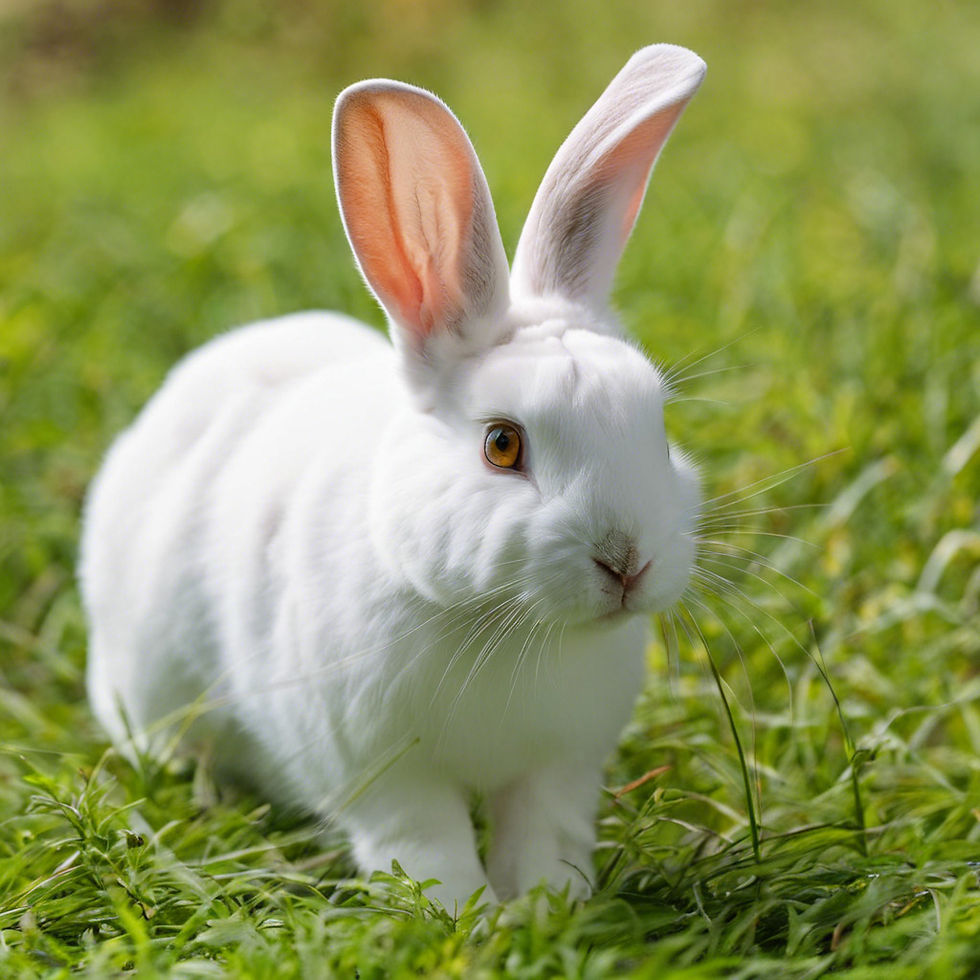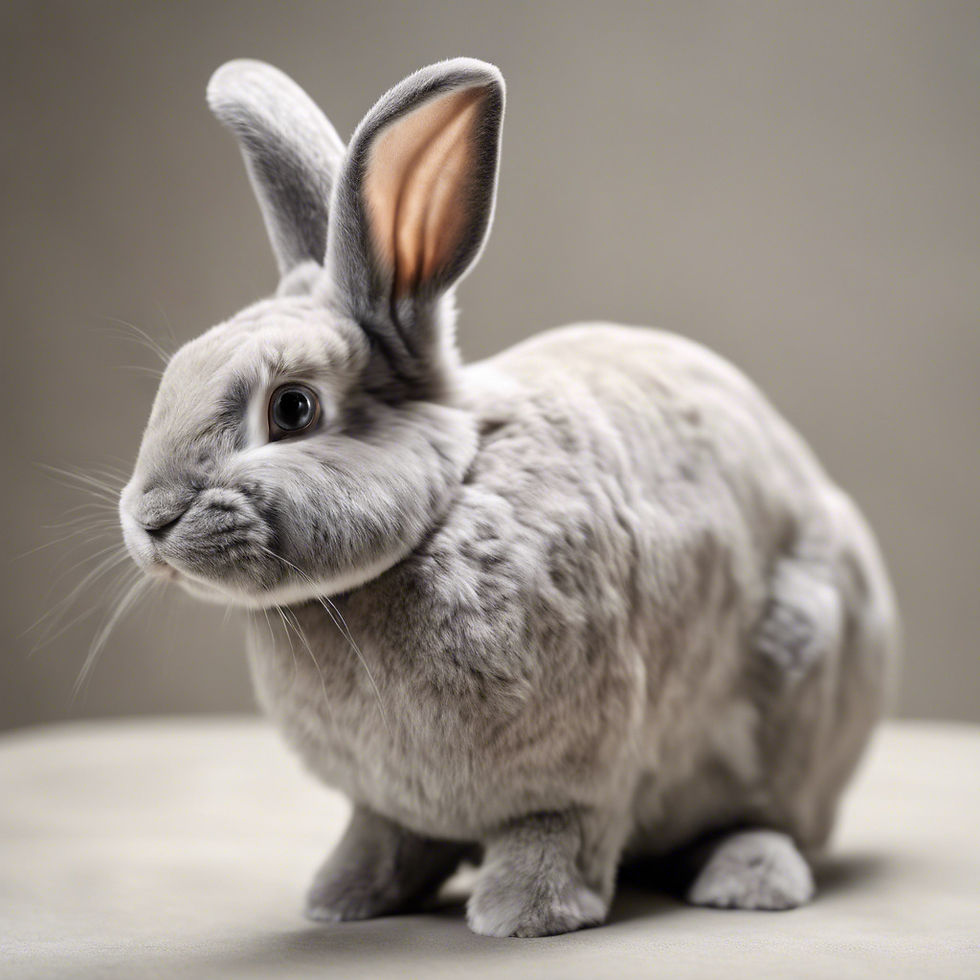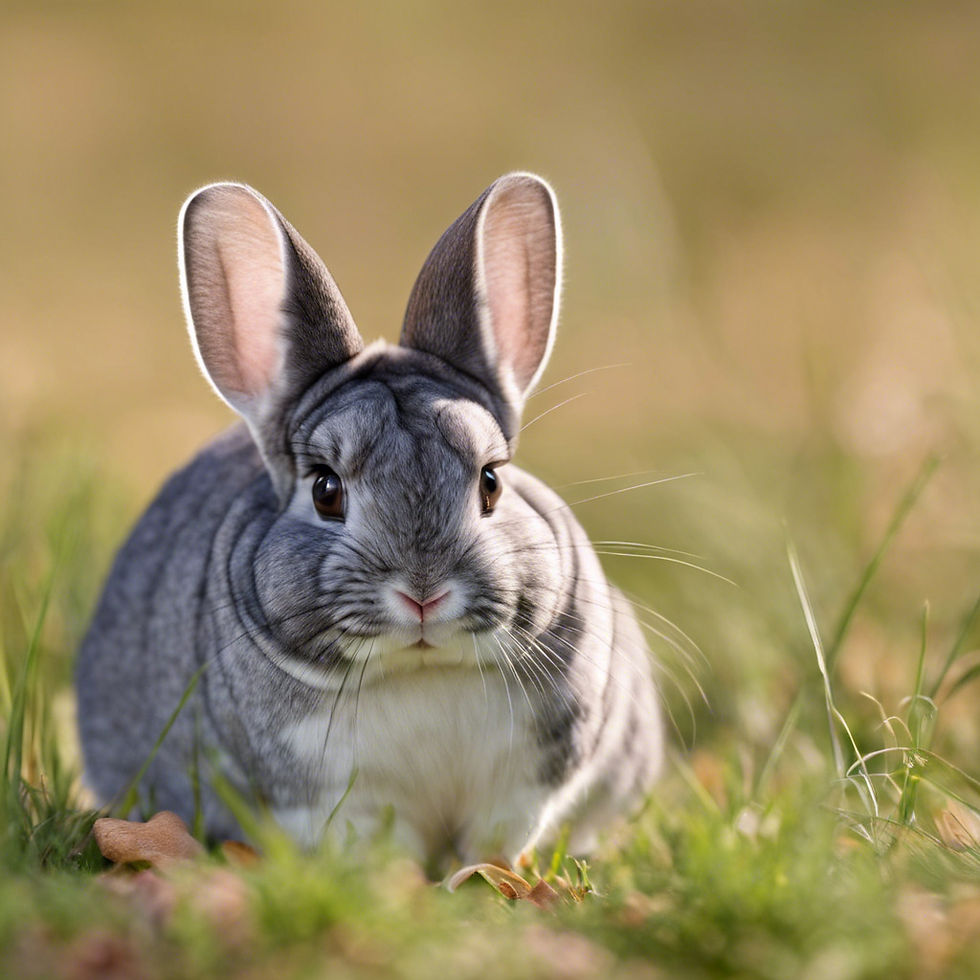The 10 Best Meat Rabbit Breeds: A Complete Guide
- atuhura owen
- Dec 12, 2024
- 8 min read
When I first started raising rabbits, I was primarily interested in them as pets. Over time, I became curious about other aspects of rabbit keeping, including their historical role as a sustainable source of meat. Researching meat rabbit breeds taught me a lot about their unique traits, and I was surprised at how diverse these breeds were.
Choosing the right breed is important, whether you’re considering raising rabbits for personal use or as part of a homestead.
In this guide, I’ll share what I learned about the top 10 meat rabbit breeds, highlighting their characteristics, benefits, and why they’ve been valued by rabbit keepers for generations.
1. New Zealand Rabbit
When I first looked into meat rabbits, the New Zealand breed immediately stood out as a top choice. Despite their name, these rabbits were developed in the United States and have become one of the most popular meat breeds worldwide.

Key Traits:
Size: Adults typically weigh 9-12 pounds.
Growth Rate: Fast-growing, reaching market weight in just 8-10 weeks.
Temperament: Docile and easy to handle, which I appreciated when managing my rabbits.
New Zealand rabbits are efficient converters of feed to meat, making them an economical choice. Their dense, white fur is also a bonus for those interested in utilizing pelts.
2. Californian Rabbit
The Californian rabbit was another breed I came across early in my research. Known for its striking appearance, this breed combines beauty with functionality, making it a favorite among homesteaders.

Key Traits:
Size: Typically weighs 8-10 pounds.
Appearance: White body with black ears, nose, feet, and tail.
Meat Quality: Known for fine-grained, tender meat.
This breed is often crossed with New Zealand rabbits to produce offspring that grow faster and have excellent meat quality. I noticed many breeders preferred Californians for their adaptability and reliable productivity.
3. Flemish Giant Rabbit
When I first saw a Flemish Giant in person, I was amazed by its sheer size. Originally bred in Belgium, this breed is known more for its size than its efficiency as a meat rabbit. However, it still deserves a spot on this list for those who prioritize quantity.

Key Traits:
Size: Can weigh up to 15 pounds or more.
Growth Rate: Slower than other meat breeds.
Dual Purpose: Often kept for meat and as show rabbits.
Although Flemish Giants require more feed due to their size, they can produce a large quantity of meat. I found them to be gentle giants with calm temperaments.
4. Champagne d’Argent Rabbit
The Champagne d’Argent is an old breed that has been prized for both its meat and its beautiful silver coat. It originated in France and has been raised for centuries.

Key Traits:
Size: Weighs 9-12 pounds.
Appearance: A striking silver coat that develops as they mature.
Meat Quality: Tender and flavorful.
When I raised Champagne d’Argents, I was impressed by their meat-to-bone ratio. They’re excellent for those who value both high-quality meat and pelts.
5. Rex Rabbit
I initially thought Rex rabbits were primarily show animals due to their luxurious fur. However, I soon learned that they are also excellent meat rabbits.

Key Traits:
Size: Weighs 8-10 pounds.
Dual Purpose: Known for their plush fur and quality meat.
Temperament: Gentle and easy to manage.
The Rex breed is ideal for anyone who wants to raise a dual-purpose rabbit. While I kept mine mainly for their soft, velvety fur, I also appreciated their meat quality.
6. Silver Fox Rabbit
The Silver Fox rabbit is a uniquely American breed, and its history intrigued me. Developed during the early 1900s, this breed was designed for both meat and fur production.

Key Traits:
Size: Weighs 9-12 pounds.
Appearance: Black coat with silver-tipped fur.
Temperament: Calm and friendly.
I found Silver Fox rabbits to be hardy and adaptable, making them an excellent choice for beginners. Their beautiful coat was an added bonus.
7. Palomino Rabbit
Palominos caught my attention because of their golden color and reputation for being efficient meat producers. They’re another American breed, developed specifically for commercial meat production.

Key Traits:
Size: Typically weighs 8-11 pounds.
Appearance: Comes in two shades—golden and lynx.
Growth Rate: Moderate, but with excellent feed conversion.
When I raised Palominos, I was impressed by how easy they were to care for. They’re friendly, adaptable, and provide high-quality meat.
8. Satin Rabbit
The Satin rabbit is known for its shiny coat and well-muscled body, making it another dual-purpose breed. I initially raised Satins for their striking fur but soon realized their meat quality was just as impressive.

Key Traits:
Size: Weighs 8-11 pounds.
Fur Quality: Glossy and smooth, perfect for pelts.
Meat Quality: Lean and flavorful.
Raising Satins taught me the value of having a versatile breed. They’re easy to handle and adapt well to different climates.
9. American Chinchilla Rabbit
The American Chinchilla was bred in the early 20th century and quickly became popular for both meat and fur. Its unique coat mimics that of the chinchilla, which is where the breed gets its name.

Key Traits:
Size: Weighs 9-12 pounds.
Appearance: Dense, gray fur with a chinchilla-like pattern.
Meat Production: High meat-to-bone ratio.
I found American Chinchillas to be productive and hardy. Their calm demeanor made them a joy to raise, and their meat quality was excellent.
10. Harlequin Rabbit.
The Harlequin rabbit is as beautiful as it is practical. This breed, originally from France, is known for its unique coat pattern and versatility.

Key Traits:
Size: Weighs 6-9 pounds.
Appearance: Alternating bands of color on their body.
Meat Quality: Tender and mild.
When I raised Harlequins, I was drawn to their playful personalities. While slightly smaller than some other meat breeds, their quick growth and manageable size made them a solid choice for my homestead.
Choosing the Right Breed for You
Selecting the best meat rabbit breed depends on your specific needs and goals. Here are some factors I considered when making my decision:
Size and Growth Rate: I prioritized breeds like New Zealand and Californian for their quick growth and market-ready weight.
Feed Efficiency: Rabbits that converted feed into meat efficiently saved me time and money.
Temperament: Since I spent a lot of time handling my rabbits, I chose breeds known for their calm and friendly nature.
Dual-Purpose Use: Some breeds, like Rex and Satin, offered the added benefit of high-quality fur.
FAQ: Best Meat Rabbit Breeds
1. What is a meat rabbit?
A meat rabbit is a breed specifically raised for its high-quality meat production. These rabbits are selected for their large size, rapid growth, and efficient feed-to-meat conversion rates. Many meat rabbit breeds are also valued for their fur, making them dual-purpose animals.
2. What are the most popular meat rabbit breeds?
The most popular meat rabbit breeds include:
New Zealand: Known for rapid growth and large size.
Californian: Valued for tender meat and efficient growth.
Champagne d’Argent: Prized for flavorful meat and silver fur.
American Chinchilla: Known for high meat yield and unique fur.
Other common breeds include Silver Fox, Rex, and Flemish Giant.
3. How do I choose the best meat rabbit breed for my needs?
Choosing the best breed depends on your goals:
For rapid growth: New Zealand or Californian rabbits are ideal.
For dual-purpose (meat and fur): Champagne d’Argent, Rex, or Silver Fox.
For homesteads with limited space: Smaller breeds like American Chinchilla or Harlequin work well.
For large-scale production: Focus on efficient breeds like New Zealand or Californian.
4. What is the average weight of a meat rabbit?
Most meat rabbits weigh between 8 and 12 pounds when fully grown. For example:
New Zealand: 9-12 pounds.
Californian: 8-10 pounds.
Flemish Giant: Can reach 15+ pounds but is less efficient for meat.
5. How fast do meat rabbits grow?
Meat rabbits typically reach market weight (around 5 pounds) in 8-10 weeks. Breeds like New Zealand and Californian are especially prized for their fast growth rates. Slower-growing breeds, such as Flemish Giants, may take longer but yield larger quantities of meat.
6. Are meat rabbits suitable for beginners?
Yes, many meat rabbit breeds are beginner-friendly, thanks to their calm temperament and adaptability. Breeds like New Zealand, Californian, and Silver Fox are particularly easy to raise, even for those new to rabbit keeping.
7. Do meat rabbits need special diets?
Meat rabbits require a diet that promotes rapid growth and good health. Their diet should include:
High-quality hay: The primary component of their diet.
Pellets: Specially formulated rabbit pellets for protein and nutrients.
Fresh greens: Romaine lettuce, parsley, and dandelion leaves.
Water: Always ensure fresh, clean water is available.
8. Can I raise meat rabbits in small spaces?
Yes, meat rabbits are well-suited to small spaces. They can be raised in hutches, cages, or small barns, as long as they have adequate ventilation, protection from predators, and enough room to move comfortably. Breeds like Californian and Rex are particularly manageable in smaller setups.
9. What are the dual-purpose meat rabbit breeds?
Dual-purpose breeds are valued for both meat and fur. Examples include:
Rex: Known for velvety fur and quality meat.
Silver Fox: Valued for its silver-tipped coat and tender meat.
Champagne d’Argent: Prized for its silver fur and flavorful meat.
These breeds are ideal for those interested in maximizing the value of their rabbits.
10. How do I care for meat rabbits during winter?
Meat rabbits are hardy animals, but they still need extra care in cold weather:
Shelter: Ensure their living area is insulated from wind and snow.
Bedding: Use straw or hay for warmth.
Water: Check water sources frequently to prevent freezing.
Diet: Provide slightly more food to help them generate body heat.
I found that breeds like New Zealand and Silver Fox were particularly resilient in colder
temperatures.
11. Are meat rabbits good for homesteaders?
Absolutely! Meat rabbits are a fantastic option for homesteaders because:
They grow quickly and require relatively low space and feed.
They provide a sustainable source of protein.
Dual-purpose breeds also offer fur for clothing or crafts.
Breeds like New Zealand, Californian, and American Chinchilla are popular among homesteaders for their efficiency and versatility.
12. How much meat can I expect from a rabbit?
On average, a rabbit weighing 5-6 pounds live yields about 2.5-3 pounds of meat after processing. The exact yield depends on the breed and how much fat or bone is present. Breeds like New Zealand and Californian have an excellent meat-to-bone ratio.
13. Do meat rabbit breeds have specific health concerns?
Most meat rabbit breeds are robust, but it’s important to watch for:
Digestive issues: Ensure their diet includes plenty of hay to avoid GI stasis.
Overgrown teeth: Provide chewing materials like untreated wood or hay.
Ear mites or infections: Check ears regularly for signs of irritation.
Regular cleaning, proper housing, and a balanced diet can prevent most health problems.
14. What is the breeding cycle for meat rabbits?
Meat rabbits are prolific breeders. Here’s what I learned about their breeding cycle:
Gestation Period: Around 28-32 days.
Litter Size: Typically 6-12 kits (baby rabbits).
Weaning Age: Kits are weaned by 4-6 weeks.
Breeds like New Zealand and Californian are known for their high fertility and mothering abilities, making them ideal for breeding programs.
15. How do I humanely process meat rabbits?
Processing meat rabbits requires care and respect for the animal. If you decide to raise rabbits for meat, ensure you:
Learn proper handling and dispatch techniques from experienced farmers or workshops.
Use sharp, humane tools to minimize stress.
Process the meat in a clean, sanitary environment.
It’s important to follow local regulations and guidelines when raising and processing meat rabbits. Taking time to learn the proper techniques will ensure a respectful and efficient process.
Raising meat rabbits taught me a lot about sustainability and self-sufficiency. Each breed on this list has its own unique qualities, and the best choice often depends on your personal goals and resources. Whether you’re looking for a fast-growing breed like the New Zealand or a dual-purpose rabbit like the Rex, there’s a perfect breed out there for everyone.
For me, raising rabbits wasn’t just about meat production—it was about connecting with a traditional practice and learning how to care for these remarkable animals. If you’re considering raising meat rabbits, I hope this guide helps you make an informed decision and appreciate the value these breeds bring to your homestead.
Comentarios